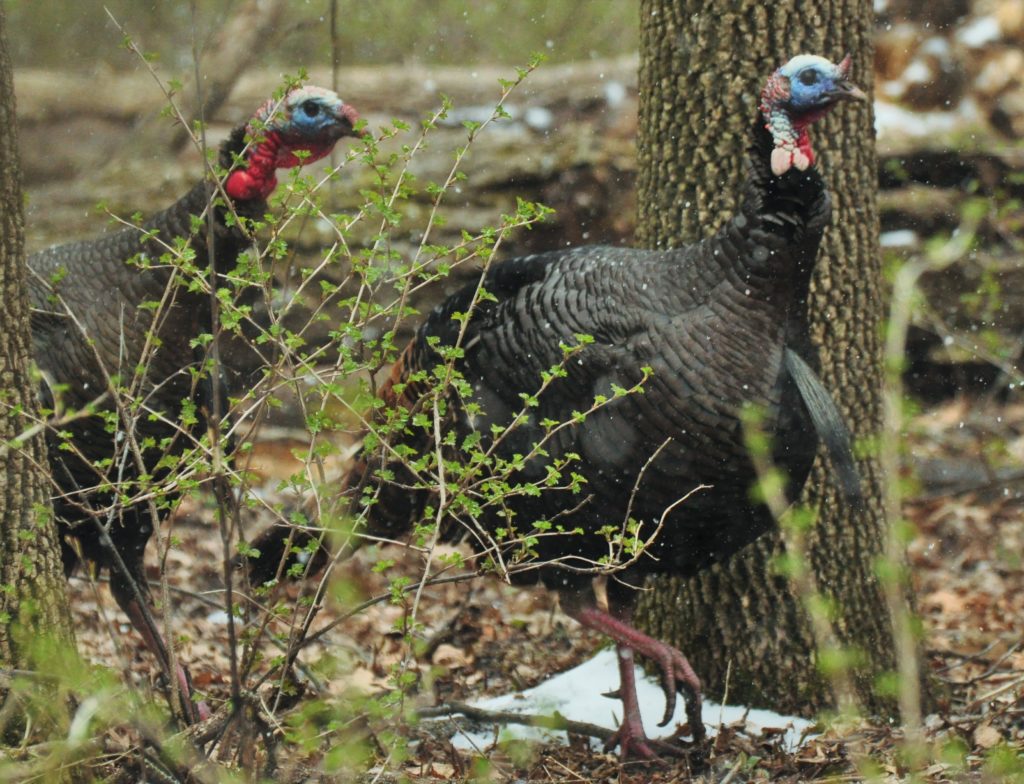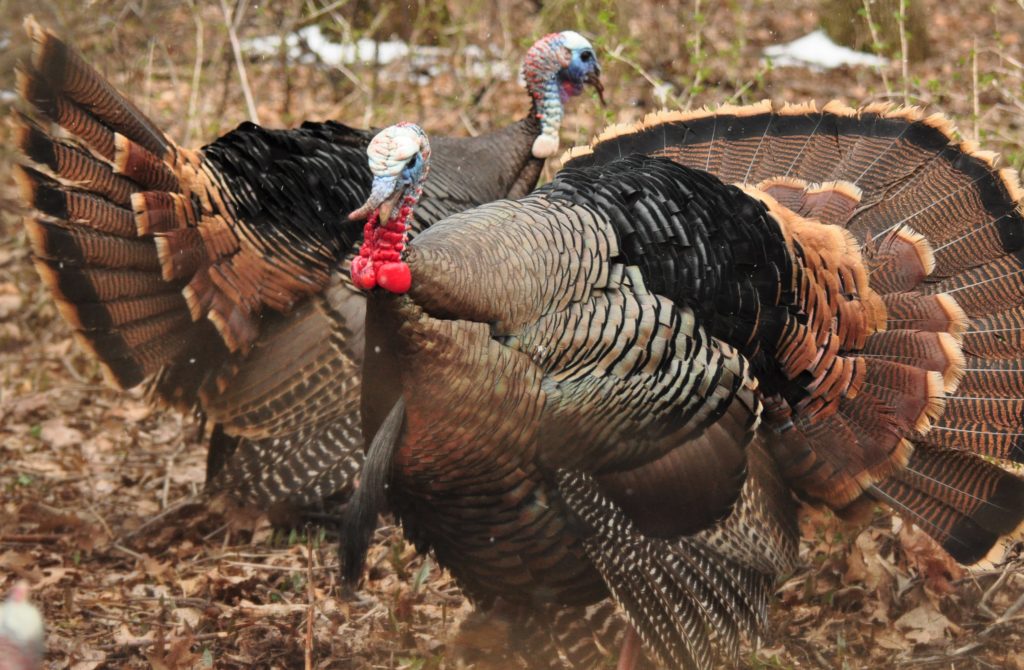Photography courtesy of Lowell Washburn, all rights reserved.
Iowa Turkey Opener Offers Blend of Feast & Famine
The first of Iowa’s four-part, split turkey seasons began Monday. But as often happens during spring turkey season, the weather did not necessarily match the calendar. Instead of singing birds and mild temperatures, early season hunters were treated to a snow-covered landscape, wind, and twenty-degree cold.
Arriving at one of my favorite public timbers, I was happy to find that the parking lots were empty. Unfortunately, so were the woods. Although the early morning woodland had resounded with the sound of gobbling during a previous scouting visit, all that greeted today’s sunrise was wind and plenty of it. The only birdlife I saw were a handful of thrushes and yellow-rumped warblers that seemed to be wondering what in the world they were doing this far north. Following an uneventful hunt, I returned home.
Skies remained clear, and by mid-afternoon most of the local snow cover had disappeared. Although I’m not much of an afternoon turkey hunter it was, after all, opening day and I had yet to see a wild turkey. It was worth a second try.
Traveling to another public timber, I was happy to find the parking lot empty – no surprise considering that it was now late afternoon. Although the wildlife area is popular with tree climbing deer hunters, hardly anyone pursues turkeys here. Dominated by ash, mature oak and incredibly dense tangles of gooseberry, visibility is limited. In most cases, every turkey you see will be under 30 yards before it’s spotted. Although most turkey enthusiasts shun this type of habitat, I love hunting spring gobblers inside this type of cover. For me, the thicker the cover, the better I like it.
Slowly moving through the thorny jungle, I eventually found an opening that offered a clear view for several yards. Popping up my portable archery blind, I placed a single jake decoy out front. Picking up the box call, I fired off a loud series of yelps. According to the weather channel, the wind was now blowing 30 mph, and gusting to 40. The roar was deafening, and I wondered how far a turkey could even hear my call. The time was 4:30.
After placing an arrow on my bow string, the next order of business was to blacken my face. I was still applying the camo paint when, looking up, I saw an astonishing sight – a majestic gobbler standing in full strut about 25 yards away. Dropping the camo paint, I quickly greeted the bird with some softer yelps. And although the tom began to immediately advance, he also failed to commit to the decoy. Instead, he strutted back and forth; forth and back; never coming closer than 15 yards. Following four of five minutes of cautious display, he simply turned his back and walked away. The bird had never uttered a single peep, and I surmised that he was probably a subdominant tom. If so, I would have loved to see the Boss Gobbler he was afraid of.
I decided against moving deeper into the woods and resumed calling from my tiny opening. The only response to my yelping was the continuing roar of the wind. Then, at around 5:15, I finally detected a faint and distant gobble. Before long, I had the bird fired up to the point that he’d cut me off every time I began to call. Unfortunately, it was a standoff. A half hour later, the gobbler was still sounding off from his same location way back in the gooseberries.
The standoff was my fault, of course. I’d been talking way too much for way too long. Time to put down the call and try to arouse his curiosity in another way. Maybe the sound of silence would make him wonder if the hen was leaving the scene.
But before totally shutting down the calling, I had one last trick. Pulling out a “Gobbler Shaker” game call, I fired off two somewhat timid rattles. Designed to imitate the sound of an immature male [jake], the call can sometimes provoke the ire of dominant birds. When I rattled the call, the real tom – for the first time in thirty minutes — went totally silent.
I assumed that now we were both curious as to what was going on. Had my fake gobbling spooked the turkey? Or was he indeed the Boss Gob, and I had pushed his buttons to the point he was already making his way in my direction — eager to teach the unseen young upstart some manners?
Fortunately, it proved to be the latter. In less than what was probably three minutes, I spotted a bright red object making its way through the tangled vegetation. It was the real deal, Mr. Boss Gobbler himself was on the way. Displaying a blood red head and neck, his agitated demeanor was anything but that of a friendly turkey. Already at twenty yards and closing, the big tom was pushing against the jake decoy within seconds. The time was 6:05.
I was carrying a longbow crafted by northeastern Iowa’s Scott Rentschler, owner of Best Friend Longbows. Drawing the bow, I focused on the base of the strutting bird’s head and released the broadhead. Like a hot knife through butter, the arrow passed through the neck just behind the jaw. It was lights out, and the gobbler collapsed on the spot. I know it’s a small target, but whether using traditional, flint, or obsidian broadheads; I prefer taking head shots at wild turkeys. The result is either a clean miss or an instant kill.

Although I didn’t yet know it, the excitement was far from over. Before I could exit the blind to claim my prize, I suddenly heard another gobble from somewhere out front. Grabbing the box call, I fired off five or six loud yelps. I got an immediate response from not one, but two separate gobblers. When I beckoned again, the birds answered in stereo. And then I saw them. Plowing through the gooseberries and leaping over deadfalls, the birds were charging in my direction as hard as they could go. Arriving at the decoy, the dynamic duo strutted, gobbled, and generally threw a fit. Judging by their spurs, the birds were at least three-year-olds.


As the show continued, a surprise snow squall suddenly turned the woodland landscape into a Christmas globe fantasy. Although the change produced a dramatic weather effect, it also dampened the gobblers’ spirits. Losing interest in the jake decoy, the birds soon vanished into the wintery blur. It was 6:20 when I finally exited the blind, picked up my turkey, and headed for the truck.

Five minutes later, the snow had stopped and the sun was shining again. You know what they say about Iowa weather – wait five minutes and it will change.
Another familiar saying is that feast or famine, “turkey hunting spins on a dime”. This year’s turkey opener had provided a classic example of both.

 Tom Cope
Tom Cope Sue Wilkinson
Sue Wilkinson Susan Judkins Josten
Susan Judkins Josten Rudi Roeslein
Rudi Roeslein Elyssa McFarland
Elyssa McFarland Mark Langgin
Mark Langgin Adam Janke
Adam Janke Joe Henry
Joe Henry Kristin Ashenbrenner
Kristin Ashenbrenner Joe Wilkinson
Joe Wilkinson Dr. Tammy Mildenstein
Dr. Tammy Mildenstein Sean McMahon
Sean McMahon